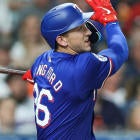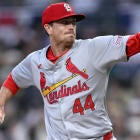Want more sleepers for your Fantasy draft? Head to SportsLine.com and check out the all-new ACES metric to find overlooked starting pitchers. You'll find some names from this list ranked surprisingly high.
A sleepers column might be the most fundamental form of Fantasy analysis and is a requirement from those who sit where I sit during draft prep season.
But the goal is mass appeal. It needs to be of the greatest use to the most people, which means it's tailored for the most popular format: the 12-team mixed league. Dig too deep, and you're advising people to draft a player who ought not be drafted, making for a poor use of roster space.
But how useful is that sleepers column to someone who plays in a 15-team league? Or a 20-team league? What about an AL- or NL-only league?
It's not useless — it still points out some of the players most likely to outperform their cost — but it doesn't go deep enough, creating a feeling of aimlessness in the later stages of those drafts.
So let's do it: deep sleepers for deeper leagues. I combed through the players who fall outside the top 300 in FanasyPros consensus ADP.
Here are my 20 favorites, sorted by position.
Catcher
Omar Narvaez may only end up starting against right-handed pitchers, but as long as the Mariners are consistent about it, it's not much less often than the typical catcher. Already an exceptional line-drive hitter and plate discipline guy, he showed just enough pop last year to emerge as something like a poor man's Yadier Molina or maybe more like Francisco Cervelli now that he's No. 1 on the depth chart.
Expected to challenge Yasmani Grandal for at-bats last spring, Austin Barnes instead found himself sidelined by a balky elbow, and by his own admission, his swing wasn't right thereafter. No duh. The kind of numbers he put up in 2017 — a .289 batting average, .408 on-base percentage and .895 OPS with 39 walks to 43 strikeouts in 218 at-bats — hinted of potential so great that, as a starter that year, he actually averaged about as many Head-to-Head points per game as a 33-homer Gary Sanchez. And now that he spent an offseason reworking his swing, with only the ancient Russell Martin to compete for his at-bats, he could still come through.
First base
Ryan O'Hearn is another player who may have a hard time cracking the lineup against tougher lefties, but with the kind of power he showed during a two-month audition last year, he'll be a Rotisserie asset regardless. Armed with an elite fly-ball rate, an elite hard-hit rate and a less-than-prohibitive strikeout rate, he's a little reminiscent of Matt Olson.
Nate Lowe doesn't have a job yet but is on the same sort of rocket trajectory that took Paul Goldschmidt from minor-league nobody to All-Star first baseman nearly a decade ago, making an adjustment last year that allowed him to turn on fastballs and unlock massive power. He was already a discerning hitter who could recognize offspeed stuff and make regular contact, so now it's the best of all worlds for the 23-year-old who hit this pulsar in the first week of spring training.
Daniel Vogelbach's power and plate discipline would suggest a possible Max Muncy ceiling, and he did everything he could to grab the Mariners' attention last spring, batting .407 with seven homers and more walks (13) than strikeouts (11) in 54 at-bats before going on to do similar things at Triple-A. Now, his biggest obstacle is Jay Bruce rather than Nelson Cruz, which should make for an easier path, and when the rebuilding Mariners eventually trade Edwin Encarnacion, even more so.
Second base
True, I included Brandon Lowe in the first edition of my more conventional sleepers list, but when it became clear no one was drafting him, I was forced to downgrade him to deep-sleeper status. But between second base, outfield and the position he's now learning, first base, he'll find at-bats, and after an 0-for-19 start to his major-league career, he validated his power-patience profile in his final 110 at-bats, batting .273 with six homers and an .884 OPS.
It hasn't gotten much attention, but the Diamondbacks are basically handing Wilmer Flores the everyday second base job after the 27-year-old had to scrap for at-bats each of the previous four seasons with the Mets. He typically did well with what he got, though, averaging 15.3 homers in 378.0 at-bats across those four seasons. Just projecting out those numbers, you're looking at a potential 25-homer guy whose low strikeout rate also gives him a high floor. Worst case, he's Asdrubal Cabrera.
The presumption of a platoon role takes Adam Frazier out of the mixed-league discussion, but he doesn't have enough of a track record against lefties to confirm he's unfit to play against them. Even if he is limited to facing righties, it'll be out of the leadoff spot (which will help salvage the at-bat total), where he'll do a pretty good Ketel Marte impression.
Third base
A world of legal troubles threatened to wreck Jung Ho Kang's once promising career, but three years later, he's back with the Pirates and already showing some of the same home run power that made him such a hot commodity during his two seasons in the States. Colin Moran is his only competition at third base, and the Pirates have made it clear Kang has an opportunity to secure full-time at-bats. So far, he appears well on his way.
Taylor Ward arrived to some fanfare last August as an emerging power-speed threat but was quickly relegated to the Fantasy back burner after he hit .178. The Angels are still excited about his potential, though, and sizing up his minor-league numbers, he's a much more disciplined hitter with much lower strikeout tendencies than he showed us in the majors. Remember how much Franmil Reyes improved from his first major-league stint to his second? There's five-category potential here if Ward can beat out light-hitting David Fletcher for the third base job.
Shortstop
Luis Urias makes so much contact with such a disciplined approach that it's hard to imagine him being completely worthless in Fantasy, particularly in the sort of deep-league scenario we're discussing here. He was also known for hitting the ball exceptionally hard in the minors, so it's possible his power could play up in the majors, as so often happens for prospects with a plus hit tool. Granted, he also puts the ball on the ground too much, but the profile is reminiscent of Jose Altuve when he first got going, minus the speed.
Outfield
The Indians have nothing going on in their outfield, meaning Greg Allen should cruise to a starting job, which should, if last year's pace is any indication, lead to a ton of stolen bases. That alone makes him a worthwhile pursuit in Rotisserie leagues, where steals are as necessary as they are scarce, but his high line-drive rate and minor-league track record — namely the excellent plate discipline he didn't show in the majors — suggest there's also more to come with the bat.
Christin Stewart was a consistent home run hitter in the minors, and power is considered his best tool. But what really sold me on him as a major-leaguer were the 10 walks compared to just 13 strikeouts in 17 games down the stretch last season. If he's as disciplined against major-league pitching as minor-league pitching, then we may have another Carlos Santana on our hands, and there are no threats to Stewart's playing time in Detroit.
Tyler O'Neill also homered nine times in 130 major-league at-bats, but it's the minor-league pace that should blow your mind. Projected over 160 games, it comes out to 65 homers, so we're talking about a transcendent power threat. He'll have to strike out less than he did during his time in the majors to amount to anything in Fantasy, but his minor-league track record suggests it's at least plausible, provided he can work his way into a crowded outfield mix.
Clint Frazier showed his clearest signs yet of living up to his lofty potential amid a season plagued by crippling concussion symptoms, and he now has his clearest opportunity yet to win a job in a big-league outfield with Brett Gardner taking a step back last year. But it feels like enthusiasm is at an all-time low for a player with "legendary" bat speed (to borrow Brian Cashman's word) and a first-round pedigree, which is undeserved given Frazier's steady, if methodical, progression to this point.
After spending last offseason retooling his swing with the same hitting guru who made Justin Turner everything he is today, Mac Williamson killed it last spring, killed at Triple-A to begin the year and killed it for about a week in the majors, hitting 460-plus-foot home runs to the opposite field, before suffering a concussion and having his entire life turned upside-down. Now recovered, there's no reason why he wouldn't get that same opportunity with the Giants, not given the current state of their outfield.
Starting pitcher
So many Fantasy analysts, including yours truly, have pointed out the bad luck Nick Pivetta incurred last year, but Zach Eflin himself had an ERA half a run higher than his FIP, suffering behind the same miserable (but now-revamped) infield. The ratios aren't as bowl-you-over as Pivetta's, but after establishing a reputation as a low-upside, pitch-to-contact type, Eflin added a couple miles per hour to his fastball last year and introduced a swing-and-miss changeup.
Anytime you see a starting pitcher with more than a strikeout per inning, it should capture your attention in Fantasy, and Trevor Richards' only got better over the course of his rookie year. His changeup is absolutely ridiculous, boasting a swinging strike rate similar to Luis Castillo's, which is sort of the gold standard for that pitch. However, he leaned on it too heavily, leading to too many hits for a guy who also struggles with walks. He threw a curveball more in his final two starts, though, and ended up striking out 17 while walking just three in 13 2/3 scoreless innings, so we'll see where he's at with that pitch this year.
Framber Valdez's late-season trial may have actually undersold his bat-missing ability seeing as he had 11.3 strikeouts per nine innings between Double- and Triple-A prior to his call-up. It's his ground ball-generating abilities that really set him a part, though. We're talking a Dallas Keuchel-level, league outlier-type downer, the sort that wouldn't even require a big strikeout rate for him to keep runs off the board. He's not as exciting as Josh James, granted, but he's the healthier of the two, which gives him the inside track on the fifth starter job.
He may technically be in a competition for the role, but the Pirates signed Jordan Lyles this offseason to be their fifth starter, releasing a statement that said they looked forward to "helping [him] bridge the gap between potential and performance." It was most likely a reference to him recognizing the importance of emphasizing his best pitch, the curveball, last season, which started in San Diego but then peaked in Milwaukee, where he struck out 22 in 16 1/3 innings of relief. It's sort of the Collin McHugh model of converting a pitcher from a pitch-to-contact sinkerballer to a genuine power arm, and it showed signs of working.


















































